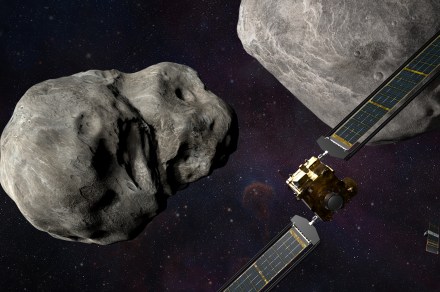
NASA has successfully crashed a spacecraft into an asteroid in the first-ever planetary defense mission aimed at changing the direction of a celestial body.
Exactly as planned, NASA’s Double Asteroid Redirection Test (DART) spacecraft slammed into the harmless 530-feet-wide Dimorphos asteroid as part of a bold test mission deploying technology that could one day be used to tackle a hazardous object heading for Earth.
The 4,000-miles-per-second impact occurred about 7 million miles from Earth at 7:14 p.m. ET (4:14 p.m. PT) on Monday, September 26, and was captured by a camera attached to the spacecraft. Never has an audience been so happy to see a live feed cut out …
IMPACT SUCCESS! Watch from #DARTMIssion’s DRACO Camera, as the vending machine-sized spacecraft successfully collides with asteroid Dimorphos, which is the size of a football stadium and poses no threat to Earth. pic.twitter.com/7bXipPkjWD
— NASA (@NASA) September 26, 2022
Astronomers will now train their telescopes on Dimorphos to measure its trajectory and see if the spacecraft has succeeded in altering the course of the asteroid. If it did, the mission will have been a major step forward in planetary defense, giving humans a great shot at avoiding the same fate of the dinosaurs if a large asteroid is ever spotted coming straight for us.
“We’re embarking on a new era of humankind,” a NASA livestream commentator said just seconds after the impact was confirmed. “An era in which we potentially have the capability to protect ourselves from something like a dangerous hazardous asteroid impact — what an amazing thing, we’ve never had that capability before.”
Last week, DART also ejected a camera called the Light Italian CubeSat for Imaging Asteroids (LICIACube). This will have flown past Dimorphos about three minutes after the impact, capturing high-resolution images of the crash site, including the plume of asteroid material thrown up by the collision, and possibly the newly formed impact crater. We’ll share these images just as soon as they become available.
Editors’ Recommendations
Credit: Source link


Comments are closed.